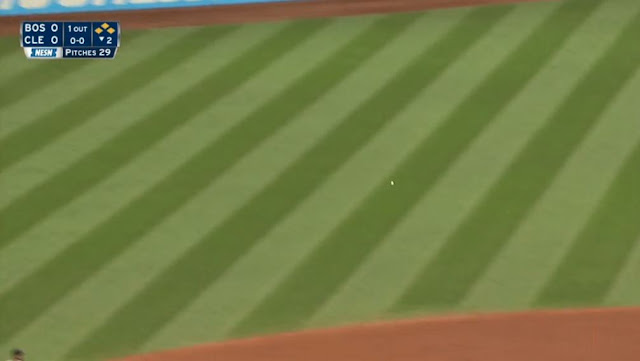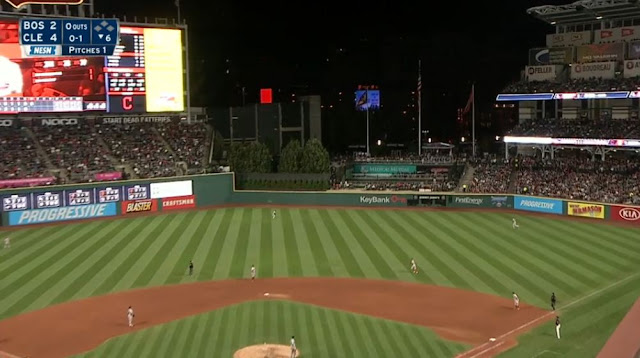NESN has been burned numerous times in the past by focusing on an outfielder as the ball sails over the fence or showing the second deck when the ball is about to be caught by an outfielder well in front of the warning track. The network now begins every play with a much wider shot of the field, guaranteeing that the action will be shown, even if the players look like ants. You often feel like you're sitting the last row of the upper deck when watching a fly ball on NESN.
B1, first batter: NESN's high-home camera trupes us on Francisco Lindor's fly to center, filling most of the screen with the area beyond the outfield wall. Jackie Bradley makes a routine catch on the warning track.
B2, second batter: Yonder Alonso
NESN's Dennis Eckersley: "I thought that ball was gone." ... Note to Eck: Stop watching the NESN feed!
B2, third batter: Melky Cabrera grounds a single to right. NESN is very slow to switch from the center field camera (showing the pitch) to the high-home camera (showing the ball going through the infield). NESN is often slow on these plays, sometimes switching on routine grounders as the infielder grabbed the ball.
B2, fourth batter: Yan Gomes doubles to the base of the left field wall. Andrew Benintendi has to lunge to his right to snag the carom.
But just as Benintendi gloves the ball, NESN switches cameras to show us Josh Donaldson jogging to the plate from third base with the game's first run. Donaldson could have walked from third to home and scored without a play, so why does NESN think showing him is more important than what Benintendi did after he fielded the ball with the batter-runner on his way to second base?
Once Donaldson has scored, we get to see the ball sailing into the infield. NESN, while so intent on giving us visual proof that the run scored, is not so prompt on updating its on-screen bug.
B2, fifth batter: Jason Kipnis lines out to first. NESN makes sure the play is in view by showing the entire right side of the field (and then some). That's less-than-ideal camera work on four straight plays.
B6, first batter: Alonso flies to center. NESN starts off with a view of (nearly) the entire field, as well as the huge video scoreboard, most of the three decks in right, and approximately 18% of the city of Cleveland.
But NESN must hedge its bets. Will the ball be caught? Will it sail 150 feet beyond the fence? Who can possibly know? NESN keeps two outfielders in the shot but also shows a shitton of real estate beyond the fence in case it's a history-making, 725-foot, tape-measure shot.
It only dares to zoom in as Bradley throws the ball back to the infield.
O'Brien was his usual self, mentioning home runs about 427 times. (Sorry for the estimate. I lost count in the seventh inning.)
While part of Eckersley's appeal is that he's so in-the-moment - he is truly the anti-OB - that spontaneous attitude can result in some silly comments. In the eighth, Eck discussed Alonso: "He's hit two balls tonight that could have been home runs." He was referring to a fly to the track in right in the second and a fly to Bradley on the track in right-center in the sixth (both shown above).
Yeah, they could have been home runs - if only he had hit them over the fence! That's like saying Player X grounded out four times, but he could have been 4-for-4 if the infielders had not caught the ball and thrown him out every time. Re Alonso: If there had been no outfielders, neither fly ball would have been a dong.
With Ramirez batting in the third, Eckersley noted that Rick Porcello had thrown "a ton" of off-speed pitches to that point. (Gameday had 16 fastballs among Porcello's 38 pitches.) O'Brien quickly agreed: "Absolutely." But O'Brien had not mentioned it before Eckersley had brought it up. This happens a lot. Eckerlsey offers an insight and O'Brien - wanting to appear equally observant - immediately acts like "Yep, I've noticed that exact same thing", but for some odd reason, he saw no reason to share that observation with the viewing audience before Eck spoke.
In the top of the first, O'Brien said Oakland's Khris Davis has hit 45 home runs, four more than J.D. Martinez. He also noted that Davis is within five RBI of Martinez (124-119), saying that's the "closest that [race] has been for a long time".
Through September 21: Martinez 124, Davis 119 (difference of 5 RBI)I'm not sure if anyone other than Davis was closer to Martinez's RBI total at any time. What I do know is this: Nothing O'Brien says should be assumed to be accurate.
Through August 21: Martinez 106, Davis 103 (difference of 3 RBI)
Through July 31: Martinez 89, Davis 84 (difference of 5 RBI)
Through June 21: Martinez 55, Davis 49 (difference of 6 RBI)









2 comments:
I usually watch the opponents TV feed. Better announcers and better camera work. You don’t have to listen to all the nonsensical statistics that OB is so fond of.
We often do the same thing.
What I like best is NESN video and WEEI audio. But the new Roku MLB app sucks -- it's pretty much unusable -- and our alternative AppleTV doesn't let you choose separate audio and video. Bah.
Post a Comment